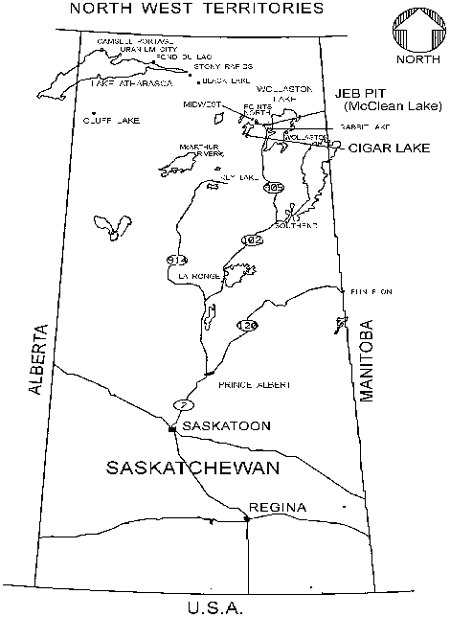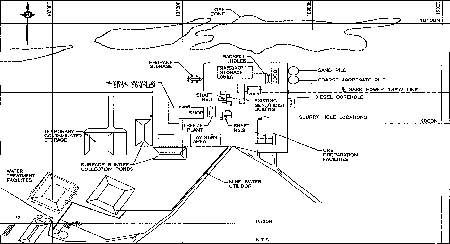Archived Content
Information identified as archived is provided for reference, research or recordkeeping purposes. It is not subject to the Government of Canada Web Standards and has not been altered or updated since it was archived. Please contact us to request a format other than those available.
Panel Report
2.0 Project Description and Site Map
2.1 Proposal
The Cigar Lake uranium deposit was discovered in 1981 at the southwestern end of Waterbury Lake, approximately 660 km north of Saskatoon. The Cigar Lake site may be reached by a temporary access road, which joins it to Points North Landing and Provincial Road 905. See Figure 1.
The Cigar Lake ore body contains the equivalent of approximately 385-million pounds of U3O8, at an average grade of 9.2 per cent. The proponent, the Cigar Lake Mining Corporation (CLMC), estimates that the reserves will support active mining for over 40 years.
Between 1987 and 1992, CLMC carried out test mining to characterize the deposit and assess proposed mining methods. The site conditions delineated in this way indicated high potential groundwater inflows, unless control procedures were applied. In response, CLMC proposes to freeze the deposit before excavating the ore. Freezing, which in addition to reducing water inflows is expected to stabilize ground conditions and limit radon migration, would be accomplished by circulating refrigerated brine through freeze pipes originating from drifts below the ore body.
Access to the development area underneath the ore body would be through the existing test mine shaft. Two underground levels would be developed, a freeze level approximately 20 to 30 m below the ore body, and a production level between the freeze level and the ore body. The freeze level would consist of parallel drifts from which vertical freeze holes would be drilled upward to about 5 m above the ore body. A brine solution, cooled to -35° C, would then be circulated through vertical tubes, freezing the entire area between the tubes from the freeze drifts to well above the ore body.
Ore would be mined from a production gallery beneath the frozen deposit using non-entry jet boring and boxhole boring methods that would minimize the exposure of miners to radioactive material. The slurry resulting from jet boring would flow through primary and secondary crushing and grinding mills, located underground, before being pumped through cased boreholes to storage tanks on the surface. The cavities remaining after ore removal would be back-filled with a special high-strength concrete mix. About thirty per cent of the mine rock excavated would be used as backfill for the freeze and production levels.
From storage, the ore slurry would be pumped into transportation containers and trucked 80 km to the McClean Lake mill for processing with the Midwest and McClean Lake ores.
Milling of the Cigar Lake ore would involve the use of a process already approved for the McClean Lake project. The McClean Lake mill would be expanded and modified to accommodate the receiving and unloading of the high-grade ore from the Cigar Lake mine site.
The tailings resulting from the milling of the Cigar Lake ore would be neutralized before being thickened to paste consistency, and disposed of subaqueously in the JEB pit at the McClean Lake site.
Over the 40-year operation of the Cigar Lake mine, approximately 1.35-million m3 of waste rock would be excavated to the surface, with most of it having the potential to be acid-generating.
Additional surface facilities needed at the Cigar Lake site to augment the existing test mine facilities would include a freeze plant; a concrete mix plant; additions to the administrative complex; an ore shipping building, which would include a primary water treatment plant; and headframes and hoist buildings for additional shafts. See Figure 2.
The Cigar Lake Project would provide work for approximately 270 persons during the development phase (about 2 years) and employ about 200 workers for the operational phase (about 40 years). An additional 350 persons would be needed for a short time to complete the expansion of the mill facilities at McClean Lake. Also, the employment life of the 132-person workforce at the mill would be extended by 25 years.
2.2 Ownership
The Cigar Lake Mining Corporation is the proponent on behalf of the Cigar Lake Joint Venture. As of August, 1997, the joint venture is comprised of Cameco Corporation (48.750%), Cogema Resources Inc. (36.375%), Idemitsu Uranium Exploration Canada Ltd. (7.875%), TEPCO Resources Inc. (5.000%) and Korea Electric Power Corporation (2.000%).
Figure 1 - Location of the Proposed Cigar Lake Project

Figure 2 - Cigar Lake Mine Site - Surface Facilities Layout

- Executive Summary
- 1.0 Introduction
- 2.0 Project Description and Site Map
- 3.0 Historical Experience of the Cigar Lake Proponent and Owners
- 4.0 Recommendations and Conditions
- 5.0 Mining
- 6.0 Mine Waste Rock Management
- 7.0 Milling and Tailings Disposal
- 8.0 Worker Health and Safety
- 9.0 Biophysical Impact Assessment
- 10.0 Decommissioning
- 11.0 Transportation
- 12.0 Community Health and Social Impacts
- 13.0 Socio-Economic Benefits
- 14.0 Miscellaneous
- Appendix A - Panel Member Biographies
- Appendix B - Terms of Reference
- Appendix C - Panel Activities
- Appendix D - Submissions to Panel
- Appendix E - Bibliography of Review Documents
- Appendix F - Participant Funding Program
- Date Modified: